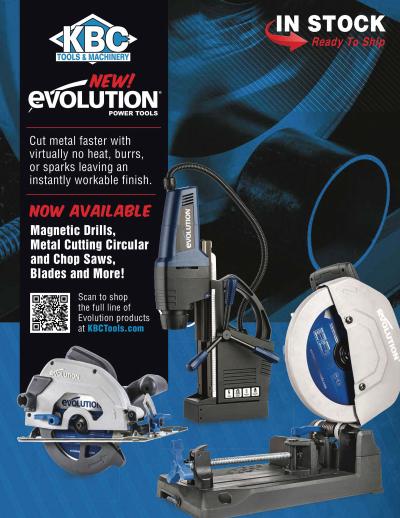
KBC Tools & Machinery is pleased to announce that it is now carrying and stocking the Evolution line of heavy duty Metal Cutting Power Tools made especially for metalworking in both Canada and The US and featuring Magnetic Drills and Circular Saws.
Now you can cut through mild steel up to 4 times faster, without heat build up or burrs…and less secondary re-work with KBC and Evolution’s Circular Saws and Magnetic Drills.
KBC stocks Evolution’s 1.1/8” and 1.5/8” Magnetic Drills with 2,860 lbs./f of magnet adhesion, ½” drill capacity, 2” maximum cutting depth, ¾” cutter shank, 10 amps, drill travel of 11.1/2”, 8 ft. rubber power chord. The Magnetic Drills also come complete with a coolant system to keep your cutting edges cool and sharp, tri-spoke spindle handle, dovetail slides, and a 2 stage magnet which allows you to precisely configure the machine for a perfect result. At only 26.5 lbs. these are light weight while still being heavy duty magnetic drills, and at a super affordable price in comparison to other magnetic drills in the market.
Accessories available for Evolutions Magnetic Drills include: step drills, countersinks, mini cutters, annular cutters, and carbide tipped annular cutters.
KBC also stocks Evolutions’s 7.1/4” Metal Cutting Circular Saw – one of the lightest circular saws on the market to get the job done. The Metal Cutting Circular Saw features 0-45” bevel capacity, adjusting rear paddle lever to set the base plate in a higher position giving a cupping caput up to 2.1/2”, 10 ft. power chord, channeled air flow and glass sight shield ensure you always have great visibility of your cutting path, included parallel edge guide to make sure you are cutting straight, a mild steel blade that has fully hardened body plates with 40 tungsten carbide teeth that generate almost no heat, sparks, or burrs – that keeps your teeth sharper for longer resulting in more cuts and a great workable finish with virtually no heat, burr, or sparks.
Contact Details
Related Glossary Terms
- burr
burr
Stringy portions of material formed on workpiece edges during machining. Often sharp. Can be removed with hand files, abrasive wheels or belts, wire wheels, abrasive-fiber brushes, waterjet equipment or other methods.
- circular saw
circular saw
Cutoff machine utilizing a circular blade with serrated teeth. See saw, sawing machine.
- coolant
coolant
Fluid that reduces temperature buildup at the tool/workpiece interface during machining. Normally takes the form of a liquid such as soluble or chemical mixtures (semisynthetic, synthetic) but can be pressurized air or other gas. Because of water’s ability to absorb great quantities of heat, it is widely used as a coolant and vehicle for various cutting compounds, with the water-to-compound ratio varying with the machining task. See cutting fluid; semisynthetic cutting fluid; soluble-oil cutting fluid; synthetic cutting fluid.
- metalworking
metalworking
Any manufacturing process in which metal is processed or machined such that the workpiece is given a new shape. Broadly defined, the term includes processes such as design and layout, heat-treating, material handling and inspection.
- parallel
parallel
Strip or block of precision-ground stock used to elevate a workpiece, while keeping it parallel to the worktable, to prevent cutter/table contact.
- sawing machine ( saw)
sawing machine ( saw)
Machine designed to use a serrated-tooth blade to cut metal or other material. Comes in a wide variety of styles but takes one of four basic forms: hacksaw (a simple, rugged machine that uses a reciprocating motion to part metal or other material); cold or circular saw (powers a circular blade that cuts structural materials); bandsaw (runs an endless band; the two basic types are cutoff and contour band machines, which cut intricate contours and shapes); and abrasive cutoff saw (similar in appearance to the cold saw, but uses an abrasive disc that rotates at high speeds rather than a blade with serrated teeth).
- shank
shank
Main body of a tool; the portion of a drill or similar end-held tool that fits into a collet, chuck or similar mounting device.
- tungsten carbide ( WC)
tungsten carbide ( WC)
Intermetallic compound consisting of equal parts, by atomic weight, of tungsten and carbon. Sometimes tungsten carbide is used in reference to the cemented tungsten carbide material with cobalt added and/or with titanium carbide or tantalum carbide added. Thus, the tungsten carbide may be used to refer to pure tungsten carbide as well as co-bonded tungsten carbide, which may or may not contain added titanium carbide and/or tantalum carbide.






